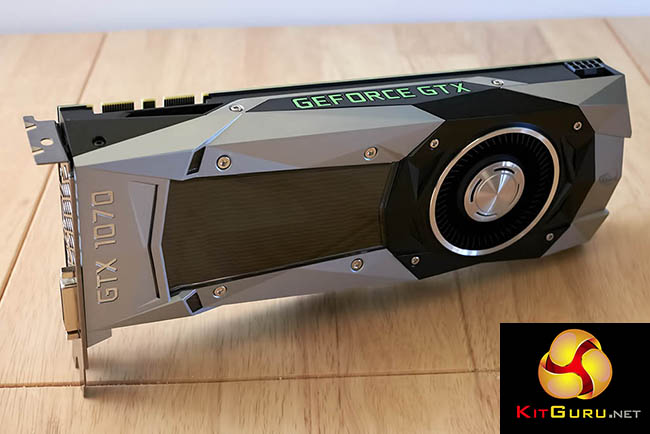Back on May 17th Nvidia released their flagship, cutting edge GTX 1080, and today we look at the second card based on their Pascal architecture. The GTX 1070 Founders Edition is built on the 16nm FinFET manufacturing process and is priced to target a wider audience. That said, at around the £400 mark gamers will still demand high levels of performance, particularly as the adoption of 1440p gaming panels continues to increase.
As with the GTX1080 launch, Nvidia have released their GTX 1070 ‘Founders Edition’ card first with pricing set at $449 and third party partner cards said to enter the market at $379. We expect UK stock to hit soon with prices starting close to £350 with higher grade, more expensive, modded cards from the likes of ASUS likely to hit around the £400 mark.
The power delivery of the GTX 1070 Founders Edition is designed with a low impedance power delivery network, custom voltage regulators and a 4 phase dual FET power supply, optimised for clean power delivery. Nvidia claim the power system of the GTX 1070 is more efficient than the GTX 970. Nvidia also optimised the power delivery network on the PCB for low impedance.
The GTX 1070 Founders Edition also incorporates a new low profile backplate with a removable section to help airflow when using multiple cards in SLi configurations. It is set for release on June 10.
| GPU | Geforce GTX970 | GeForce GTX980 |
Geforce GTX 980 Ti | Geforce GTX Titan X | Geforce GTX 1080 | Geforce GTX 1070 |
| Streaming Multiprocessors | 13 | 16 | 22 | 24 | 20 | 15 |
| CUDA Cores | 1664 | 2048 | 2816 | 3072 | 2560 | 1920 |
| Base Clock | 1050 mhz | 1126 mhz | 1000 mhz | 1000 mhz | 1607 mhz | 1506 mhz |
| GPU Boost Clock | 1178 mhz | 1216 mhz | 1075 mhz | 1076 mhz | 1733 mhz | 1683 mhz |
| Total Video memory | 4GB | 4GB | 6GB | 12GB | 8GB | 8GB |
| Texture Units | 104 | 128 | 176 | 192 | 160 | 120 |
| Texture fill-rate | 109.2 Gigatexels/Sec | 144.1 Gigatexels/Sec | 176 Gigatexels/Sec | 192 Gigatexels/Sec | 257.1 Gigatexels/Sec | 180.7 GigaTexels/sec |
| Memory Clock | 7000 mhz | 7000 mhz | 7000 mhz | 7000 mhz | 5005mhz | 4006mhz |
| Memory Bandwidth | 224 GB/s | 224 GB/sec | 336.5 GB/sec | 336.5 GB/sec | 320GB/s | 256GB/s |
| Bus Width | 256bit | 256bit | 384bit | 384bit | 256bit | 256 bit |
| ROPs | 56 | 64 | 96 | 96 | 64 | 64 |
| Manufacturing Process | 28nm | 28nm | 28nm | 28nm | 16nm | 16nm |
| TDP | 145 watts | 165 watts | 250 watts | 250 watts | 180 watts | 150 watts |
The Nvidia GTX 1070 ships with 1920 CUDA cores and 15 Streaming Multiprocessors – reduced from 2560 and 20 on the GTX 1080 respectively. While the GTX 1080 is equipped with 160 Texture Units, the GTX 1070 has to make do with 120. The 8GB of GDDR5 memory runs at a data rate of 8Gbps.
Based on the same GP104 GPU used in the GTX 1080, the GTX 1070 has all of the key features that NVIDIA’s Pascal architecture enables, including Simultaneous Multi-Projection. Nvidia claim the GTX 1070 has a 70% performance lead over the last generation GTX 970. While the GTX 1080 used GDDR5x memory, the GTX 1070 is shipped with fast GDDR5.
If you want to read more on the Pascal architecture, head to our page, over HERE.

